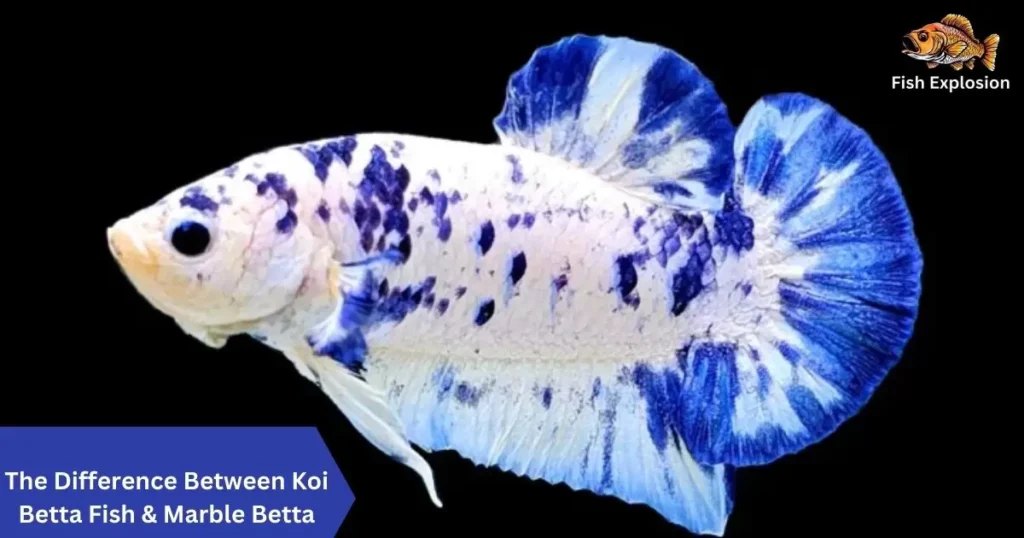Koi betta fish are a beautiful and popular variety of Siamese fighting fish. They require a well-maintained aquarium of at least 5 gallons with a filter and heater to keep the water between 76-82°F. The tank should have lots of live plants and decorations for them to swim around and rest on near the surface. Feed them high-quality pellets or frozen/live foods like brine shrimp 2-3 times per day in small portions they can eat within 2 minutes. Perform weekly 25-50% water changes using a dechlorinator to remove any buildup of waste and ammonia that can make them sick. With proper care, these vibrantly colored fish can live 3-5 years in home aquariums.
What is Koi Betta Fish?

Koi betta fish are a relatively new and striking variety of the popular Siamese fighting fish (Betta splendens). They are similar in care requirements to Giant Betta Fish but are bred specifically for their vivid koi-inspired colors and patterns. Like other bettas, they have long flowing fins and an iconic labyrinth organ that allows them to breathe air from the surface. Their unique appearance makes them a signature choice for aquarium enthusiasts, though their requirements are similar to regular bettas and Giant Betta Fish in terms of tank size, filtration and water parameters.
However, koi bettas stand out with their calico patterning of orange, white, black, blue, and yellow markings layered over iridescent scales. Their unique appearance, curious personalities, and tolerance for nano aquariums have quickly made them a favorite among aquarium hobbyists. Despite their brilliant colors, koi bettas are the same species as traditional bettas and have similar care requirements.
Original Habitat of Koi Betta fish
Though selectively bred in captivity, koi betta fish share the same ancestral origins as other members of the Betta splendens species. Their original natural habitat is the shallow, stagnant waters of floodplains, rice paddies, and ancient Buddhist temple grounds across Thailand, Cambodia, and other parts of Southeast Asia.
In these warm, humid environments, bettas thrived among thick aquatic vegetation and murky waters rich in organic matter. Their labyrinth organ evolved to breathe air directly, allowing them to survive oxygen-depleted conditions.
The natural biodiversity in their native Southeast Asian waters, with their ever-changing water levels and environmental conditions, gave rise to the incredible genetic diversity we now see expressed in domesticated Koi Betta color morphs.
Recreating aspects of this original tropical habitat is key to keeping koi bettas healthy in captivity.
The History of Koi Betta Fish
The koi betta fish variety emerged in the early 2000s as an innovative breed developed by passionate betta hobbyists. Even though Siamese fighting fish had been tamed for centuries, breeders were motivated to deliberately create new, bold color varieties of bettas by the striking patterns and colors of koi carp.
By carefully controlling genetic lines and spawning only the most brilliant and distinctly patterned fry, they gradually intensified the iridescent oranges, whites, blacks, and blues that resembled koi markings. Within a few years, these “koi betta” or “Dragon Betta” strains exploded in popularity in the aquarium trade.
What was once merely a creative experiment became an established and highly sought-after “mustard gas” variety among collectors and fish enthusiasts worldwide. The koi betta represented a new era of professional betta breeding to develop ever more dazzling color forms.
The Difference Between Koi Betta Fish & Marble Betta

Here is a table comparing koi betta fish and marble betta fish:
| Characteristic | Koi Betta | Marble Betta |
| Coloration | Bold calico patterns of orange, white, black, blue resembling koi carp | Swirling/marbled mix of two or more solid colors |
| Color Patterns | Distinct patches of color, may appear painted or layered | Colors blended throughout body and fins |
| Color Consistency | Colors remain stable throughout life | Colors may change and marble over time |
| Breeding | Line-bred for specific koi patterning | Not line-bred, colors produced randomly |
| Fin Types | All betta fin types possible (veil, crown, plakat, etc.) | All betta fin types possible |
| Origins | Developed by breeders in early 2000s | Natural genetic mutation |
| Rarity | Less common, newer variety | More common, occurs naturally |
| Price | Generally more expensive | Generally less expensive |
The key distinctions are the specific koi-like calico patterning of koi bettas versus the more random marbling of marble bettas. Koi bettas are an artificially developed and line-bred variety, while marbles occur naturally as a genetic mutation.
Koi Betta Fish appearance
Koi betta fish are renowned for their eye-catching appearance, which truly sets them apart. Their bodies feature bold calico patterns with distinct patches of brilliant orange, pure white, jet black, and electric blue hues reminiscent of Koi carp.
These vivid colors appear layered over iridescent scales that shimmer underneath, creating a stunning visual effect. Flowing fins and tails complete their majestic look, displaying the same mesmerizing koi-like markings.
Difference Between Male & Female Koi Betta
Koi bettas are a variety of Siamese fighting fish that have been selectively bred for their unique and striking appearance. Their colors and patterns mimic those of koi carp, with bold calico markings.
Appearance: Their bodies sport distinct patches of brilliant orange, white, black, and blue hues that seem painted on. These colors layer over iridescent scales that shimmer underneath the water. Long, flowing fins and tails carry the same eye-catching koi-like markings.
Coloration: The calico patterning results from genetic mutations and selective line breeding by hobbyists. No two Koi bettas exhibit exactly the same coloration or pattern placement. Maintaining high-quality water conditions helps preserve their vibrant colors.
Aggression: Like other Betta splendens, male Koi bettas are territorial and shouldn’t be housed together. However, proper tank setup and environment can minimize aggressive behavior. Females and younger bettas tend to be less aggressive than mature males.
Gender: Males are more vibrantly colored, with long, flaring fins used for displays. Females tend to be smaller, with shorter fins and a vertical breeding stripe. Koi bettas exhibit a pronounced difference in size/coloration between genders.
Common Types of Koi Betta Fish
Plakat Koi Betta
Plakat Koi Bettas are known for their short fins and muscular build, resembling the traditional fighting Betta. They showcase a marbled pattern of bright colors, mimicking the appearance of Koi fish. Their vibrant coloration often includes a mix of red, white, and black patches, making them a favorite among aquarists for their striking appearance.
Halfmoon Koi Betta
This variety is admired for its large, dramatic tail that spreads 180 degrees like a fan, resembling the shape of a half moon. Halfmoon Koi Bettas display a kaleidoscope of colors that blend and shift over time, offering a dynamic visual display in home aquariums. They require careful handling to maintain their delicate fins and vivid colors.
Crowntail Koi Betta
It is distinguished by its spiky tail and fin rays that extend beyond the fin membrane, giving it a regal, crown-like appearance. These Bettas combine the striking patterns of Koi with the unique fin structure of the Crowntail, creating a visually stunning fish. They are hardy and can adapt to a variety of water conditions, making them suitable for both beginners and experienced fish keepers.
Veiltail Koi Betta
They are known for their long, flowing tails that gracefully trail behind them. Their patterns are reminiscent of traditional Koi fish, with splashes of orange, white, and black. This variety is less common in the Koi Betta world but is highly sought after for its elegant finnage and vivid coloration, which make a peaceful and mesmerizing addition to any aquarium.
Ultimate care guide for Koi Bettas
Tank Set Up
Setting up a tank for Koi Betta fish involves creating an environment that closely mimics their natural habitat to ensure their health and well-being. A minimum tank size of 5 gallons is recommended to provide ample swimming space.
The tank should be equipped with a gentle filtration system to keep the water clean while minimizing strong currents that can stress the Bettas. The temperature should be maintained between 76 to 80 degrees Fahrenheit with a heater, as Koi Bettas thrive in warm water.
Live plants, such as java ferns and anubias, can be added to offer hiding spots and enhance the tank’s aesthetics. Substrate choice can vary, but smooth gravel or sand is preferable to prevent fin damage. A well-planned tank setup not only supports the physical health of Koi Betta fish but also encourages natural behavior, making them more active and vibrant.
Tank Mate of Koi Betta
Choosing tank mates for Koi Betta fish requires careful consideration to ensure compatibility and prevent aggression.
Ideal companions include small, peaceful species such as neon tetras, harlequin rasboras, and Corydoras catfish, which do not compete for territory and are not prone to nipping fins.
It’s crucial to maintain a spacious tank with plenty of hiding spots and plants to reduce stress and provide refuge, allowing for a harmonious aquatic community. Monitoring interactions during the initial period is essential to ensure peaceful coexistence and adjust the tank setup or inhabitants as necessary.
Koi Betta Sorority
It refers to a setup housing multiple female Koi Bettas together, a practice that can create a visually stunning and dynamic aquarium but requires careful management. To ensure success, the tank should be spacious (20 gallons or more), heavily planted, and structured with plenty of hiding spaces to minimize aggression and establish a hierarchy among the females.
Regular monitoring and maintenance are crucial to prevent stress and aggression, making a Koi Betta Sorority both a challenging and rewarding experience for advanced aquarists seeking to showcase the beauty of these fish in a communal environment.
What Is The Diet of Koi Betta?
- Varied Diet: Koi Betta fish thrive on a diet that includes a mix of high-quality pellets or flakes designed specifically for Bettas, ensuring they receive all necessary nutrients.
- Live Foods: Incorporating live foods such as brine shrimp, daphnia, and bloodworms into their diet encourages natural hunting behaviors and provides essential proteins.
- Frozen and Freeze-dried Foods: These are convenient alternatives to live foods, offering similar nutritional benefits and variety to keep Betta’s diet balanced.
- Vegetation: While primarily carnivorous, Koi Bettas can benefit from the occasional inclusion of blanched vegetables or specialized plant-based foods to mimic the variety they might encounter in the wild.
- Feeding Schedule: Overfeeding should be avoided, with small, controlled feedings twice a day being ideal to maintain health and prevent water quality issues caused by excess food decay.
Common Diseases in Koi Betta Fish
Koi Betta fish, like all aquarium fish, are susceptible to several common diseases, including fin rot, which is characterized by fraying or disintegrating fins, often caused by poor water quality or bacterial infections. Ich, another prevalent disease, manifests as white spots covering the fish’s body, requiring immediate treatment with raised water temperatures and medication.
Additionally, Koi Bettas can suffer from swim bladder disorder, leading to buoyancy issues, often resulting from overfeeding or poor diet. Prompt identification and treatment of these ailments are crucial for the health and longevity of Koi Betta fish, emphasizing the importance of regular water testing and observant care.
Breeding Koi Betta Fish
It is a fascinating but complex process that begins with selecting healthy, vibrant males and females with desirable traits. The breeding tank should be prepared with shallow water, warm temperatures, and a hiding place for the female.
Once the male builds a bubble nest and the courtship dance leads to spawning, it’s crucial to remove the female for her safety, leaving the male to care for the eggs until they hatch into fry, signaling the start of a meticulous rearing phase to ensure the survival and growth of the young Bettas.
Where can you buy Koi Betta Fish?
- Local Pet Stores or Aquarium Shops
- Online Retailers and Breeders
- Aquarium Shows and Expos
- Social Media Groups and Forums
FAQ’s
How do you take care of a Koi Betta fish?
Maintain clean, warm water (around 76-81°F) in a tank of at least 5 gallons, with a filter, heater, and hiding spots.
What do Koi Betta fish eat?
They thrive on a diet of high-quality betta pellets, frozen or live foods like brine shrimp and daphnia.
What is the proper care for a betta fish?
Provide a spacious tank with warm, clean water, a balanced diet, and enrichment like plants and caves to explore.
How long do Koi Betta fish live?
With proper care, Koi Bettas can live for 3 to 5 years.
Conclusion
Koi Betta fish make fascinating additions to aquatic tanks due to their vibrant colors and unique patterns. However, as ornamental fish, they do require special care and attention to thrive. This care guide provided valuable information about housing, feeding, water parameters, and filtering needs specific to Koi Bettas.
While simple to care for relative to other fish, keeping Koi Bettas successfully means replicating their natural habitat as much as possible in an aquarium setting. With the right tank size, water quality maintenance, a nutritious diet, and enough stimulation, these dramatic looking fish can live up to three years – allowing their unique personalities and colors to be enjoyed for much longer.
Koi Bettas are peaceful community fish when kept alone or in small sororities. Following the husbandry recommendations summarized here will lead to healthy, appreciative fish.
With three years of dedicated expertise in the niche of fish, my domain knowledge encompasses breeding, habitat maintenance, health management, and sustainable aquaculture practices, ensuring optimal outcomes in the aquatic realm.











